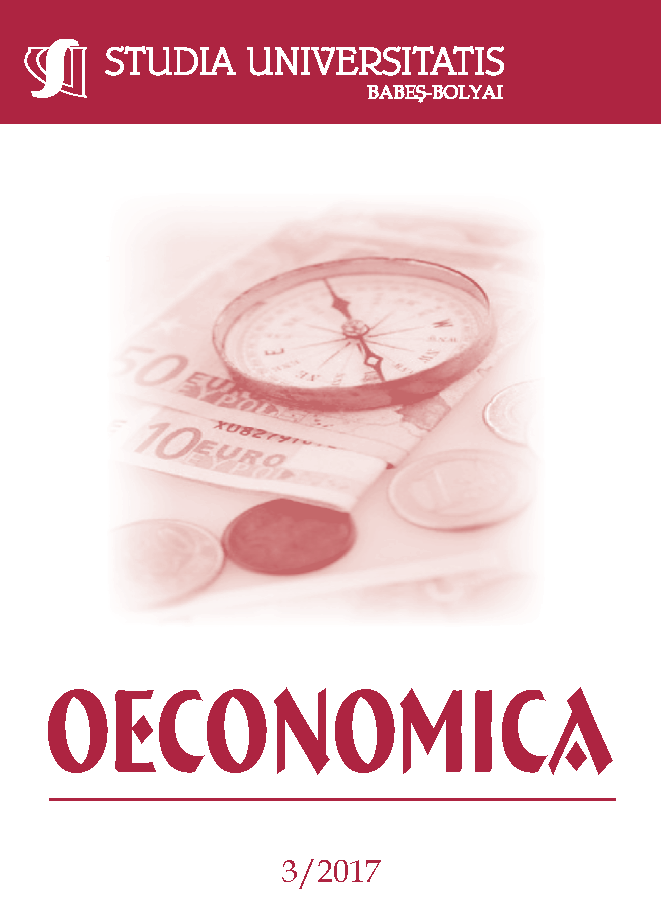BANKS’ VULNERABILITY AND FINANCIAL OPENNESS ACROSS CENTRAL AND EASTERN EUROPE
Keywords:
banks’ systemic vulnerability, financial openness, capital regulations.Abstract
https://doi.org/10.1515/subboec-2017-0013
This paper investigates the impact of the degree of capital account openness on banks’ exposure to extreme events during the period 2005-2012 using a sample of financial institutions from Central and Eastern Europe. The empirical output highlights a positive and strongly significant impact of a higher degree of financial openness on banks’ systemic vulnerability. Robust findings suggest that this harmful effect is lower for foreign owned banks or for those whose bank holding company signed one or more Vienna Initiative commitment letters. On the other side, tighter capital regulations and private monitoring policies enhance the positive impact of a higher degree of capital accounts openness on banks’ vulnerability to systemic events.
JEL classification: G21, G28, G32
References
Acemoglu, D., A. Ozdaglar, and A. Tahbaz-Salehi (2015) Systemic risk and stability in financial networks, American Economic Association, 105 (2), 564-608.
Acharya, V. V., Engle, R. F. and Richardson, M. (2012) Capital Shortfall: A new approach to ranking and regulating systemic risks, American Economic Review, 102 (3), 59–64.
Adams, Z., Füss, R. and Gropp, R. (2014) Spillover effects among financial institutions: A State-Dependent Sensitivity Value-at-Risk (SDSVaR) approach, Journal of Financial and Quantitative Analysis, 49, 575-598.
Adrian, T., Brunnermeier, M. (2016) CoVaR, American Economic Review, 106 (7), 1705-41.
Adrian, T., Shin, H.S. (2010) Liquidity and leverage, Journal of Financial Intermediation, 19 (3), 418–437.
Allen, F., and D. Gale (2000) Financial contagion, Journal of Political Economy, 108,1-33.
Allen, F., Gale, D. (2007) Understanding financial crises, Clarendon Lecture Series in Finance, Oxford: Oxford University Press.
Anginer, D., Demirgüç-Kunt, A., Zhu, M. (2014) How does deposit insurance affect bank risk? Evidence from the recent crisis, Journal of Banking and Finance, 48, 312–321.
Babus, A. (2016) The formation of financial networks, Journal of Economics, 47, 239-272.
Barth, J.R., Caprio, G., Levine, R. (2013) Bank regulation and supervision in 180 countries from 1999 to 2011, Journal of Financial Economic Policy, 5 (2), 111-219.
Betz, F., Hautsch, N., Peltonen, T.A. and Schienle, M. (2016) Systemic risk spillovers in the European banking and sovereign network, Journal of Financial Stability, 25, 206–224.
Bostandzic, D., Pelster, M., Weiß, G.N.F. (2014) Systemic risk, bank capital, and deposit insurance around the world, Working Paper TU Dortmund University.
Brunnermeier, M. and Pedersen, L.H. (2009) Market liquidity and funding liquidity, The Review of Financial Studies, 22, 2201-2238.
Chinn, M.D., Ito H. (2006) What matters for financial development? Capital controls, institutions, and interactions, Journal of Development Economics, 81 (1), 163-192.
Chinn, M.D., Ito H. (2008) A new measure of financial openness, Journal of Comparative Policy Analysis, 10 (3), 309-322.
Cifuentes, R., G. Ferrucci, and H. S. Shin (2005) Liquidity risk and contagion, Journal of European Economic Association, 3(2), 556-566.
Cont, R., Moussa, A. and Santos, E.B. (2013) Network structure and systemic risk in banking systems. In: Langsam, J.-P., an Fouque, J.A. (Eds.), Handbook on Systemic Risk. Cambridge University Press, pp. 327-368.
Correa, R., Lee, K.H., Sapriza, H., Suarez, G.A. (2014) Sovereign credit risk, banks’ government support and bank stock returns around the world, Journal of Money, Credit and Banking, 46 (1), 93–121.
Dasgupta, A. (2004) Financial contagion through capital connections: A model of the origin and spread of bank panics, Journal of the European Economic Association, 2 (6), 1542-4774.
Drehmann , M. and Tarashev, N. (2013) Measuring the systemic importance of interconnected banks, Journal of Financial Intermediation, 22 (4), 586–607.
Filipović, D.and Trolle, A.B. (2013) The term structure of interbank risk, Journal of Financial Economics, 109 (4), 707-733.
Freixas, X., B. Parigi, and J. C. Rochet (2000) Systemic risk, interbank relations and liquidity provision by the central bank, Journal of Money, Credit and Banking, 32, 611-638.
Hautsch, N., Schaumburg, J. and Schienle, M. (2015) Financial network systemic risk contributions, Review of Finance, 19, 685–738.
Minoiu, C., Kang, C., Subrahmanian, V.S. and Berea, A. (2015) Does financial connectedness predicts crises?, Quantitative Finance, 15 (4), 607-624.
Weiß, G.N.F., Bostandzic, D. and Neumann, S. (2014) What factors drive systemic risk during international financial crises?, Journal of Banking and Finance, 41, 78-96.
Downloads
Published
How to Cite
Issue
Section
License
Copyright (c) 2017 Studia Universitatis Babeș-Bolyai Oeconomica

This work is licensed under a Creative Commons Attribution-NonCommercial-NoDerivatives 4.0 International License.






